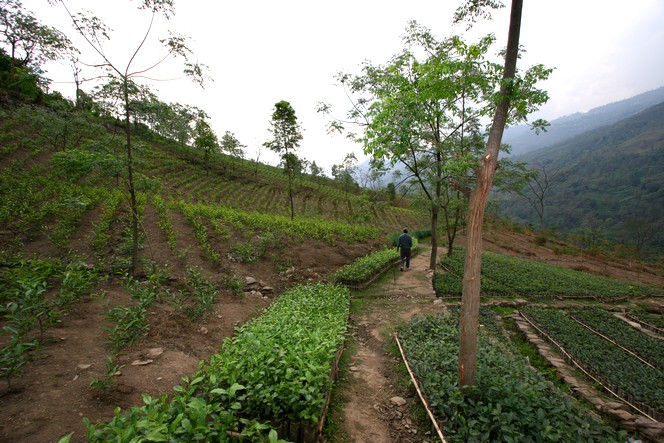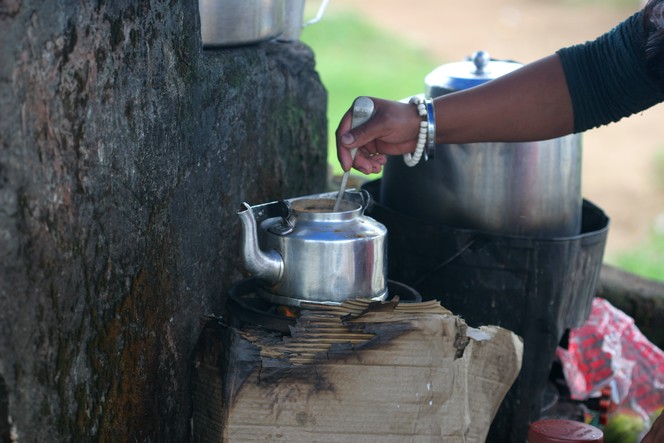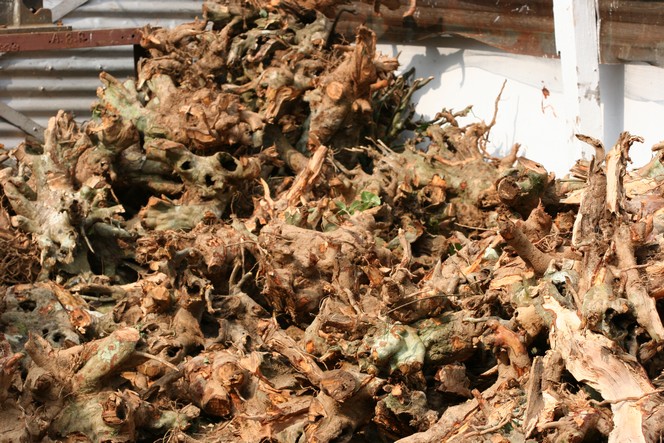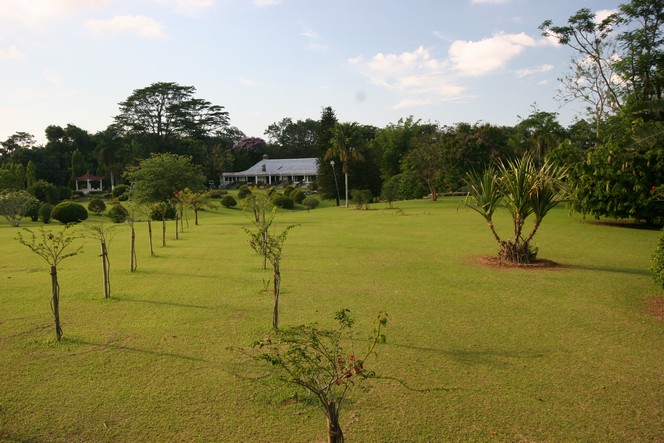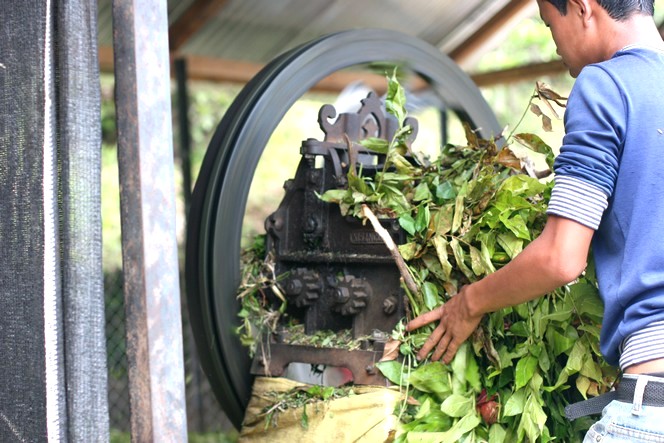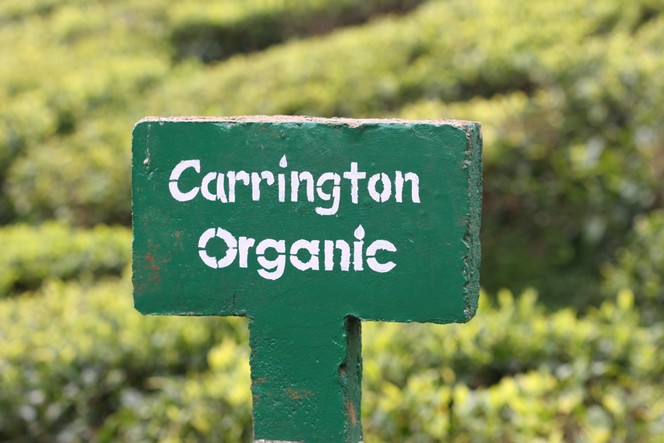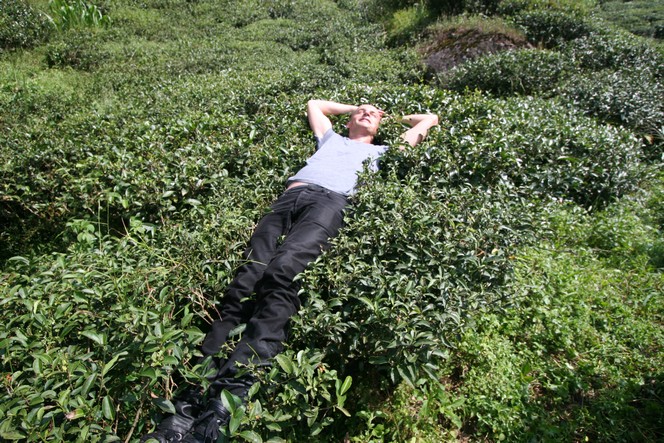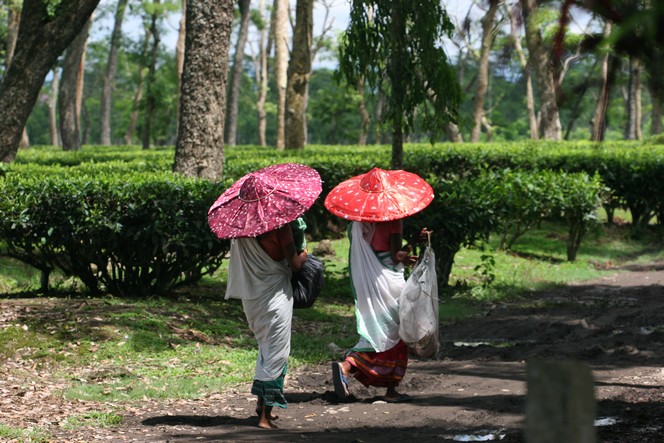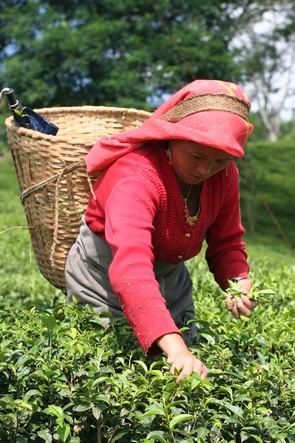During the winter months, tea plants grow very little, if at all. So this is the time to work on maintaining the land, such as the cuttings garden, for example. This is an area planted with bushes from which cuttings are taken. The plants are therefore chosen with great care. Each parent tea plant, like here in the cuttings garden at the Namring Tea Estate (India), can provide between 50 and 300 cuttings a year.
India
How to warm up with tea
With the cold you are battling in France at the moment, you need to keep warm. Always have to hand a kettle filled with fresh water. A singing kettle, for example, whose song warms the soul and lifts the spirits.
A song calling you for tea.
Everywhere in India you see tea vendors in the streets and on the roadsides. With a kettle purring over what are sometimes simple wood fires, they are always busy. On the roads of the Himalayas, they might set up stall on the corner of a rock. You squat down next to the vendor and take your time sipping the scalding blend of tea, milk and spices. You simply take time to do yourself some good.
The lifespan of a tea plant: between 30 and 50 years
Everything comes to an end. When a tea plant no longer produces many leaves, it is replaced. The lifespan of a tea plant is quite variable, generally between 30 and 50 years, although China claims to have some that are a thousand years old.
The trunk and roots of the tea plant burn well, and heat the oven in which the tea leaves are dried after oxidisation, for example.
A planter’s estate typical of the British era
When the British were in charge of tea production they created vast estates and put in place systems to manufacture large quantities of tea. On each estate they built a bungalow, which might be small or large, for the planter. Today, in India and Sri Lanka, for example, you still see these buildings that are typical of the British era. I am often invited by planters to stay in their bungalows, like this one in Amgoorie (India), which is generally considered to be one of the finest.
Vermiculture: a very common practice
You don’t need panda excrement to launch into organic tea production. In my last post I mentioned these loveable mammals in the light of the highly-publicised start-up by a Chinese entrepreneur. But vermiculture, on the other hand, has been around for a long time and is used on many tea plantations. So what is it? Quite simply, it involves raising earthworms by feeding them on a mixture of cow dung and chopped-up leaves (see photo). A few weeks later, the earthworm castings are collected and spread onto the soil. The use of this rich compost eliminates the need for fertilisers. In addition, the compost contains worm eggs, which then hatch into worms themselves. Once they have grown into adult worms, they will help aerate the soil and aid irrigation. As well as burrowing tunnels, the worms feed on leaves that have fallen to the ground, and speed up their decomposition.
So earthworms are a great asset, providing ongoing benefits for the soil.
A tea grown in panda poo
There are many organic tea plantations around the world, like here in southern India. So far, there are relatively few in China, but a publicity-seeking Chinese entrepreneur has just announced with great fanfare in the press that he has acquired no less than 11 tonnes of panda poo to make the most expensive tea in the world. Wow! Over the weekend, the news was relayed around the world by all the major press agencies. When the story reached Philippe Bouvard, master of French humour, he called me to ask if I’d appear on his show “Les Grosses Têtes” (“Big Heads”).
As for me, I consider it perfectly normal to use animal manure to grow tea. I have visited many plantations that use vermiculture, or worm composting, a technique I want to cover in my next post.
Organic farming methods don’t allow the use of chemical fertilisers, and I have no issues with that at all. However, if this Chinese entrepreneur really wants to sell the most expensive tea in the world, he’ll need a bit more than these 11 tonnes of manure. He’ll need to acquire the expertise. It won’t make the headlines, and it will take a lot longer.
Tea is not just a drink, it’s a whole way of life
Over time, as its leaves are picked and its growth hindered, the tea plant becomes stronger. Its trunk thickens and new branches appear, while the bush is maintained at a height of about a metre. The plants mesh together to form what is known as the “plucking table”, comprising branches so dense that you can lie down on them with no difficulty at all.
I don’t need to tell you, who are kind enough to accompany in my peregrinations throughout the year, how one can find a sense of serenity by taking time out every day to savour tea. But perhaps you didn’t know that you can find wellbeing with tea in a different way, by diving into the tea plants and taking a nap on their branches.
Tea is not just a drink, it’s a whole way of life. It is what makes me feel good. For 2012, I hope we can all find in tea the feeling of relaxation and serenity that we need. Together, let’s enjoy tea!
To all my readers, I wish a happy New Year’s Eve
When I left Darjeeling in October, it didn’t seem to sadden these school children in the slightest, and they had fun clowning around while I took a photo of them. This image of happy children is a good reflection of my feelings as we finish the year on a high note. I hope you enjoy the celebrations.
I have no more regrets about leaving 2011 behind me than these kids had at seeing me depart for the valley. I welcome 2012 with open arms, as they will do when I return to see them next time.
It only remains for me to choose the tea on which to end the year. After the meal I’m serving on New Year’s Eve, I think I’ll make my guests a mint tea, known for its digestive properties and as a symbol of hospitality.
See you next year!
A little touch of warmth to finish the year off
As we walk the final stretch of the path together in 2011, I want to show you this photo of two tea pluckers in the Assam region who are returning home to their village after work. I think the sight of these women protecting themselves from the sun’s rays beneath their pretty parasols brings a touch of warmth to our grey winter. In this season, Paris lacks bright colours. Apart from the inevitable Father Christmas here and there outside the department stores, you don’t see much red. So it’s funny to think that somewhere else on this earth, people are taking care to protect themselves from the sun, while here, the slightest ray of sun makes us close our eyes and purr like cats.
Red is also the colour of some chillies, so I’ll take this opportunity to tell those who’ve never tasted Assam teas that they develop subtle notes of tobacco, honey and also… spices.
A Christmas basket filled with tea leaves
I am well aware that at the moment, everyone is looking forward to the imminent arrival of a certain somebody dressed in red and bearing a sack filled with wonderful things. I truly understand! This plucker dressed all in red and wearing her apron, is taking great care as she plucks the most delicate leaves of the tea plant before she places them in her basket.
If her slender ankles appear down your chimney, make sure you give her a warm welcome and put the kettle on. It’s time to honour the contents of that famous basket: it’s time for a cup of tea!

